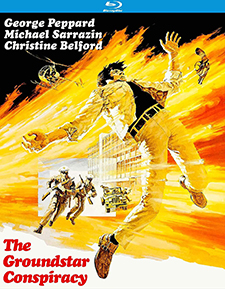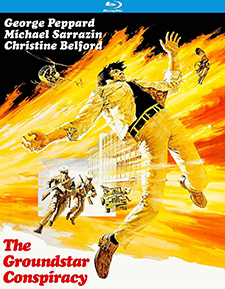Groundstar Conspiracy, The (Blu-ray Review)

Director
Lamont JohnsonRelease Date(s)
1972 (October 6, 2020)Studio(s)
Hal Roach Studios/Universal Pictures (Kino Lorber Studio Classics)- Film/Program Grade: B-
- Video Grade: B-
- Audio Grade: B-
- Extras Grade: C
Review
The Groundstar Conspiracy is a Cold War-era spy thriller about terrorism and national security with nods to North By Northwest, Saboteur, and Ministry of Fear. A hard-as-nails security chief determined to get to the bottom of a treasonous plot to undermine the United States must get essential information from a suspect who may or not be suffering from amnesia.
In the film’s explosive opening sequence, we see a computer research complex named Groundstar blown up, a top-secret tape stolen, several scientists killed, and the perpetrator thrown clear of the conflagration. Badly injured, his face burned and horribly disfigured, he barges into a nearby house and terrifies its owner, Nicole (Christine Belford).
Groundstar is a joint venture of the Air Force and the private sector and has the backing of a U.S. senator. Its head of security, Tuxan (George Peppard), has complete jurisdiction and makes that clear when representatives turn up to assert their authority.
The saboteur, Welles (Michael Sarrazin, They Shoot Horses, Don’t They?), says he has no memory of committing the terrorist act, stealing vital information, or killing six men. He claims not to know who hired him or even his own name. Tuxan soon tracks him down, takes him into custody, questions him and subjects him to torture, but to no avail.
The film becomes a battle of wills between Tuxan and Welles with the security expert focused on learning who hired the saboteur. With access to a seemingly unlimited budget and resources, Tuxan relies on know-how, instinct, and experience to discover and follow clues. Welles slips out from his grasp but Tuxan still contrives to keep him under surveillance, convinced he will lead him to the terrorist mastermind.
George Peppard (Breakfast at Tiffany’s, How the West Was Won), a big star in the first half of the 1960s, was offered less-than-stellar roles in later years. The Groundstar Consiracy is an exception. Peppard fits the role perfectly. His Tuxan conveys strength and a “don’t mess with me” bravado exemplified by how he deals with high-ranking officials early in the film. Neither intimidated nor deflected from his purpose, the character is arrogant, impatient with interference, and clearly the most powerful presence in the film.
Welles is reminiscent of Roger Thornhill in North By Northwest. Both characters find themselves in the midst of deadly spy intrigue and seem to have no idea why. Sarrazin has a boyish quality that makes him look more like a high school coach than an international spy. When he claims he has amnesia, is he telling the truth or is it a ruse to cover his tracks? His wide-eyes and innocent manner might conceal a masterful spy or they might reflect his true self.
The screenplay by Matthew Howard is engaging, mostly because Peppard’s Tuxan is the film’s most interesting character. Though the plot revolves around Sarrazin’s Welles, the script and Peppard’s strong screen presence make his the starring role. The stolen tape is merely a McGuffin. The real story is how Tuxan uses Welles to discover who is the head bad guy.
Nicole, who goes from hostage to helper, manages the unlikely task of falling in love with Welles, a dumb cliche that’s impossible not to see coming. This plot contrivance is an obvious way to tie Nicole to the espionage intrigue.
Despite the otherwise good script, the film has the look of a made-for-TV movie rather than a studio feature. The opening sequence is very brief and rushed, with little suspense. People run, fires break out, alarms go off, but it all happens so quickly that the impact is ho-hum rather than Wow! This is an opportunity missed, and there are others. Many scenes are staged with little movement and excessive dialogue, which slow the pace. When Peppard is on screen, everything moves fast, which reflects the ability of his character to get things done fast. Sarrazin’s scenes, by comparison, often drag. Locations are limited, and director Lamont Johnson often uses traditional camera set-ups rather than interesting compositions. The payoff of the film is its ending, which does offer a surprise.
Featuring1080p resolution, the Blu-ray from Kino Lorber Studio Classics is presented in the widescreen format of 2.35:1. The 2K restoration of the film is not as impressive as previous releases from Kino Lorber. Though the film is almost 50 years old, there are no physical imperfections, such as dirt specks, scratches, or emulsion clouding. Much of the image has a blue cast, with many scenes taking place at night or in dim light. The Technicolor photography has an appropriately desaturated look, not the vibrant color palette of MGM musicals. Flesh tones are warm and natural, but details are not especially sharp. The widescreen frame is not used to full advantage by cinematographer Michael Reed, who often darkens the left and right to focus attention on the actors mid-screen. The film’s limited budget is apparent, with only a few action set pieces and a helicopter sequence to enhance production value.
The soundtrack is English Mono DTS-High Definition Master Audio. Optional English SDH subtitles are included. Explosions, sirens, and the whirring of a helicopter’s rotors come across murky. Dialogue is recorded clearly, and the principal actors enunciate well, but the dialogue has a tinny sound. Peppard has a commanding, military-like voice, which he uses to underscore Tuxan’s powerful role as security chief. The volume level is poor. Sometimes dialogue can barely be heard; at other times, the sound is deafening. At two points in the film, the sound completely drops out. I’m not sure if this is a unique issue with the disc or a more widespread problem. The score by Paul Hoffert is not distinctive and is used in obvious ways to enhance the few action scenes or accompany romantic moments. The music lacks the full-range sound of recent films.
Bonus materials on the PG-rated Blu-ray release include an audio commentary and several theatrical trailers.
Audio Commentary – Film historian and filmmaker Daniel Kremer and film critic Scout Tafoya share this commentary. Much of it deals with other films, with the two men seeming to delight in their own arcane knowledge of obscure films rather than providing solid details about The Groundstar Conspiracy. The two opening sequences are contrasted—the placid scene of Nicole walking in her home and the fiery conflagration at the Groundstar complex. The JFK assassination gave rise to the conspiracy film, which saw a resurgence in the 1970s during the Watergate investigations. A “man-on-the-run action espionage film,” The Groundstar Conspiracy was made by Universal and looks as if it might have been shopped around as a TV series. The first third, in particular, has the vibe of a made-for-TV movie, with many TV actors featured in the cast. Both George Peppard and Michael Sarrazin were under contract to Universal and worked a lot for that studio both on TV and in feature films. By 1972, Peppard had resigned himself to playing roles in second-tier films and not being directors’ first casting choice. At the time, Universal was re-editing series episodes and failed pilots and releasing them as features. Universal films had a similar look though shot by different directors. Studio executives had a keen understanding of the film business, sensed what the audience “would tolerate," and used contract players to keep costs down. The film was shot in Vancouver, which had not yet become the bustling center of movie production it is today. Director Lamont Johnson worked a lot on the TV anthology show The Twilight Zone, where he learned how to make the most of composing a frame. Other conspiracy films are noted and highlights in the careers of Lamont Johnson and actors George Peppard, Michael Sarrazin, and Christine Belford are discussed.
Theatrical Trailers – The following trailers are included: The Groundstar Conspiracy, P.J., Newman’s Law, and The Reincarnation of Peter Proud.
– Dennis Seuling

